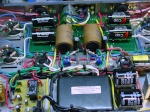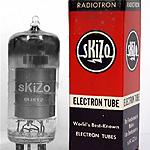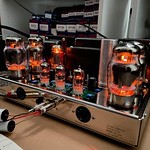Hi fellow DIY folks . I have had an st-120 for a couple of years and I was wondering if someone had an opinion on a good [INEXPENSIVE] frequency E Q to use between My cd player and my st 120 [with the passive pre amp volume control] and i have way too much bass. I have a McIntosh pre amp but it is always set with the bass almost all the way off and the treble about the 9 oclock position . Any help would be much help. thank you scott in Eugene,Oregon
5 posters
BIAS adjustment on the VTA ST 120

scottlowe- Posts : 38
Join date : 2014-04-05
Sorry but I forgot to say I am driving a pair of LaScalla

arledgsc- Posts : 503
Join date : 2012-11-30
Hello Scott and welcome... That seems unusual but not familiar with your setup. What tube are you running? Scott

sKiZo- Posts : 1530
Join date : 2013-04-01
Location : Michigan USA
Instead of trying to kill the bass with eq, I'd first look into finding out why you have the problem. I'd think it's more a room acoustics issue, and killing the problem frequencies will also tend to take out a lot of the good stuff too. My first guess is that you have an overly square room that's creating a standing wave that just muddies things up as it bounces back and forth. That can usually be cured with relocating the speakers - even a few inches can make a world of difference. Don't forget toe - a slight angle shouldn't hurt the imaging and can kill the bad if you're patient. Distance from the side and back walls is also critical. Does LaScala have any recommendations for typical placement for those particular speakers?
Personal experience - I had a killer standing wave at 160hz that I was able to tame by hanging floor to ceiling fiberglass insulated curtains behind the system. Rule of thumb is to deaden one of two parallel surfaces. Worked for me anyway.
***
If you want to try something easy and cheap. Maybe you can just get away with a set of bass blockers.
http://www.crutchfield.com/S-Yorzqq4WXUy/p_127BB300A2/Bass-Blockers-300-Hz-cut-off.html
You can just add those to the positive terminal of each speaker. It'd help if you knew about where the BOOM was though as there's several different cutoff freqs available. Those also top out at 50wpc, so maybe not a good idea if you're one to crank it regularly. Be warned though - as I mentioned earlier, you'd lose a LOT of good mid bass using these, and would probably want to replace that with an adjustable sub ...
Personal experience - I had a killer standing wave at 160hz that I was able to tame by hanging floor to ceiling fiberglass insulated curtains behind the system. Rule of thumb is to deaden one of two parallel surfaces. Worked for me anyway.
***
If you want to try something easy and cheap. Maybe you can just get away with a set of bass blockers.
http://www.crutchfield.com/S-Yorzqq4WXUy/p_127BB300A2/Bass-Blockers-300-Hz-cut-off.html
You can just add those to the positive terminal of each speaker. It'd help if you knew about where the BOOM was though as there's several different cutoff freqs available. Those also top out at 50wpc, so maybe not a good idea if you're one to crank it regularly. Be warned though - as I mentioned earlier, you'd lose a LOT of good mid bass using these, and would probably want to replace that with an adjustable sub ...

Roy Mottram- Admin
- Posts : 1839
Join date : 2008-11-30
I'd agree with Skizo here. Especially with LaScalla speakers, hopefully your room is bigger than 20x20 and has 12' or higher ceilings, these speakers are huge and effiecent and put out about 100X more bass than most of us are lucky enough to have compared to a typical 8" speaker with 88db of sensitivity that needs 60 watts.
You only need about 1 watt of power to blast you out of the room with bass (and midrange, and treble!!). You'll need a lot of sound dampening on at least one wall and floor.
Changing their location can make a huge difference. I know their is a Klipsch forum on the internet that has tons of great info just like this forum does.
https://community.klipsch.com/
You only need about 1 watt of power to blast you out of the room with bass (and midrange, and treble!!). You'll need a lot of sound dampening on at least one wall and floor.
Changing their location can make a huge difference. I know their is a Klipsch forum on the internet that has tons of great info just like this forum does.
https://community.klipsch.com/

corndog71- Posts : 840
Join date : 2013-03-19
Location : It can get windy here
Consider a lower powered amp like the VTA ST70 or perhaps an ST35 (with EFB mod.) Check out Bottlehead for low power Single End Triode amps such as their Stereomour or S.e.X. Amp.
I agree speaker placement and room tuning should also be seriously considered. This is probably even more important than what amp you use.
I agree speaker placement and room tuning should also be seriously considered. This is probably even more important than what amp you use.

sKiZo- Posts : 1530
Join date : 2013-04-01
Location : Michigan USA
I did a LOT of room tuning over the years and was able to flatten the response a bunch from what I started with. I then went through several EQ approaches, both graphic and parametric, to fine tune the little stuff. Incremental improvements, but I knew I could do still better. Best hardware results were with a Technics SH9010 parametric - way beyond what I could get with any graphic I tried, including those with RTA capabilities.
Got into DSP (Digital Signal Processing) after building a digital server here. Transferred all my CDs and such to that in FLAC format, and also digitized a good bit of my vinyl - quite the project, and still working on it. That allowed me to replace the EQ hardware with DSP plugins that do the same thing, only better. No more limits on the number of filters, and the ability to build better filters using software. Here's what I used to analyze the room and create the filters, using a calibrated microphone at the listening position.

Once the filters are created, just import them to my player's convolution engine (jRiver Media Center), sit back and enjoy. I did this all maybe a year back and really haven't felt the need to make any changes, and can't say as I miss tweaking sliders and tone controls at all. I still use the SH9010 parametric for true vinyl playback, but the only changes I make to that are an occasional tweak on the low shelf filters to tame any hiss on some selections. The overall EQ using that is quite good - for hardware.
Then again, I recently discovered a new approach that's supposed to be even better by factoring in more variables ... reflections, decay, driver performance ... so the search continues ... but I'm getting close ... well, closer ...

So. Short version ... depends on what you're willing to settle for. But also worth repeating, you need to get the room as close as possible with appropriate hardscaping first.
PS ... did I mention I'm a bit OCD? Yeah ... definitely!
Got into DSP (Digital Signal Processing) after building a digital server here. Transferred all my CDs and such to that in FLAC format, and also digitized a good bit of my vinyl - quite the project, and still working on it. That allowed me to replace the EQ hardware with DSP plugins that do the same thing, only better. No more limits on the number of filters, and the ability to build better filters using software. Here's what I used to analyze the room and create the filters, using a calibrated microphone at the listening position.

Once the filters are created, just import them to my player's convolution engine (jRiver Media Center), sit back and enjoy. I did this all maybe a year back and really haven't felt the need to make any changes, and can't say as I miss tweaking sliders and tone controls at all. I still use the SH9010 parametric for true vinyl playback, but the only changes I make to that are an occasional tweak on the low shelf filters to tame any hiss on some selections. The overall EQ using that is quite good - for hardware.
Then again, I recently discovered a new approach that's supposed to be even better by factoring in more variables ... reflections, decay, driver performance ... so the search continues ... but I'm getting close ... well, closer ...

So. Short version ... depends on what you're willing to settle for. But also worth repeating, you need to get the room as close as possible with appropriate hardscaping first.
PS ... did I mention I'm a bit OCD? Yeah ... definitely!

scottlowe- Posts : 38
Join date : 2014-04-05
Thank you all so much and yes when i first put thi equipt together I did have a large room 24'x32' with a 20' ceiling ht. and yes I now have it in a 12'x12' room with a 9' ceiling and it does not work . So I guess I just need some advice on what material to use to dampen the room. Or will that be enough and I am also a bit ocd ! Scott in beautiful sunny Eugene

sKiZo- Posts : 1530
Join date : 2013-04-01
Location : Michigan USA
Ah. The dreaded cube room. Equal dimensions are always a challenge.
First step would be to play with speaker placement. Any and all options that don't make you have to walk over them ...
Next up - tame parallel surfaces. Floor/ceiling - one or the other needs carpet. Carpeting the floor is the conventional approach there. Even a largish throw rug should help a lot. Pad or break up either one or the other of each wall pair with hangings, drapes, pics, bookshelves, whatever ... it's all about breaking up flat surfaces.
Me, I blew out the back wall and made it into an arch to the adjoining room. Bit drastic, but hey, music is important to me. DO make sure it's not a bearing wall before you get out the sledgehammer ... the last thing you may hear is the roof caving in, and I'm sure you're not gonna care how acoustically perfect THAT sounds ...
First step would be to play with speaker placement. Any and all options that don't make you have to walk over them ...
Next up - tame parallel surfaces. Floor/ceiling - one or the other needs carpet. Carpeting the floor is the conventional approach there. Even a largish throw rug should help a lot. Pad or break up either one or the other of each wall pair with hangings, drapes, pics, bookshelves, whatever ... it's all about breaking up flat surfaces.
Me, I blew out the back wall and made it into an arch to the adjoining room. Bit drastic, but hey, music is important to me. DO make sure it's not a bearing wall before you get out the sledgehammer ... the last thing you may hear is the roof caving in, and I'm sure you're not gonna care how acoustically perfect THAT sounds ...

Roy Mottram- Admin
- Posts : 1839
Join date : 2008-11-30
- Post n°10
 Re: BIAS adjustment on the VTA ST 120
Re: BIAS adjustment on the VTA ST 120
you can find a ton of stuff on the internet using google.
many years ago there was an article on making your own bass traps, which is probably what you need especially in a room that small with such magnificent bass speakers.
If you don't want to use "tubes" as bass traps, you could also make a couple of corner panels using one sheet of plywood, rip it in half the long way so you wind up with two pieces 2' wide by 8' tall, and then cover those with about 2" or better fiberglass covered with some nice material (staple gun makes it easy) or acoustic foam glued on to the panels,
then put them diagonally in the corners behind your speakers. Also look for "live end dead end" or "LEDE" although that term hasn't been used much in the past 10-15 years.
Also, if you don't have this book, Complete Guide to Hi End Audio then get it!
many years ago there was an article on making your own bass traps, which is probably what you need especially in a room that small with such magnificent bass speakers.
If you don't want to use "tubes" as bass traps, you could also make a couple of corner panels using one sheet of plywood, rip it in half the long way so you wind up with two pieces 2' wide by 8' tall, and then cover those with about 2" or better fiberglass covered with some nice material (staple gun makes it easy) or acoustic foam glued on to the panels,
then put them diagonally in the corners behind your speakers. Also look for "live end dead end" or "LEDE" although that term hasn't been used much in the past 10-15 years.
Also, if you don't have this book, Complete Guide to Hi End Audio then get it!

Guest- Guest
- Post n°11
 Re: BIAS adjustment on the VTA ST 120
Re: BIAS adjustment on the VTA ST 120
sKiZo wrote:I did a LOT of room tuning over the years and was able to flatten the response a bunch from what I started with. I then went through several EQ approaches, both graphic and parametric, to fine tune the little stuff. Incremental improvements, but I knew I could do still better. Best hardware results were with a Technics SH9010 parametric - way beyond what I could get with any graphic I tried, including those with RTA capabilities.
Got into DSP (Digital Signal Processing) after building a digital server here. Transferred all my CDs and such to that in FLAC format, and also digitized a good bit of my vinyl - quite the project, and still working on it. That allowed me to replace the EQ hardware with DSP plugins that do the same thing, only better. No more limits on the number of filters, and the ability to build better filters using software. Here's what I used to analyze the room and create the filters, using a calibrated microphone at the listening position.
Once the filters are created, just import them to my player's convolution engine (jRiver Media Center), sit back and enjoy. I did this all maybe a year back and really haven't felt the need to make any changes, and can't say as I miss tweaking sliders and tone controls at all. I still use the SH9010 parametric for true vinyl playback, but the only changes I make to that are an occasional tweak on the low shelf filters to tame any hiss on some selections. The overall EQ using that is quite good - for hardware.
Then again, I recently discovered a new approach that's supposed to be even better by factoring in more variables ... reflections, decay, driver performance ... so the search continues ... but I'm getting close ... well, closer ...
So. Short version ... depends on what you're willing to settle for. But also worth repeating, you need to get the room as close as possible with appropriate hardscaping first.
PS ... did I mention I'm a bit OCD? Yeah ... definitely!
we are the knights who say 'NI'..............

scottlowe- Posts : 38
Join date : 2014-04-05
- Post n°12
 Re: BIAS adjustment on the VTA ST 120
Re: BIAS adjustment on the VTA ST 120
sKiZo HA HA HA I am a carpenter so the bearing wall should not be an issue. and your right these sound so correct outside . no wall no lids...

scottlowe- Posts : 38
Join date : 2014-04-05
- Post n°13
 Re: BIAS adjustment on the VTA ST 120
Re: BIAS adjustment on the VTA ST 120
Yeah I also have two st 70's and its for sure the room
